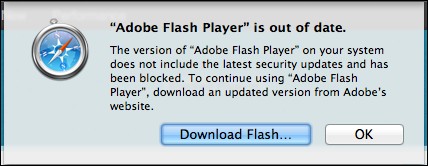Recently, many Safari users started seeing blocked plug-in errors when viewing webpages. The fix is easy, but why this is occurring is something that everybody should understand.
Apple has recently decided to have Safari block outdated versions of Adobe Flash. As much rich media advertising uses Flash (including what is displayed here on Tech-Recipes), many users are seeing “blocked plug-in” messages on almost every website that visited.
The Fix
By clicking one of these blocked areas, you will be directed to update your Flash plugin.

A drop-down box will appear that explains that the Adobe Flash Player is out of date and that it has been blocked. By selecting the Download Flash… option, you can update your player. Of course, you can also update directly from Adobe as well. Afterwards, you will need to restart your browser and you should no longer see the “blocked plug-in” messages. Well, you won’t see them again until another security issue is found with the Flash Player.
Why did Apple start blocking outdated Flash?
Apple has long railed against Adobe’s flash technology. When the iPhone was released, Apple decided not to allow Adobe Flash due to security and performance issues. In April 2010 Steve Jobs posted his thoughts on Flash in detail. Included in that article, Jobs reported that “Flash is the number one reason that Macs crash.” Most recently Macs had their most public and widespread trojan attack from the Mac Flashback malware. This trojan was installed by masquerading as a Flash Player update.
By forcing users to update to the latest Flash version, Safari is reducing many of the problems associated with this ubiquitous plugin. Newer versions of the Flash Player should have more crash inducing and performance reducing bugs fixed. Updates allow security holes to be forced closed. Additionally, by having a standard way to prompt the user for Adobe updates, trojan mimics should be less likely to fool the user.

